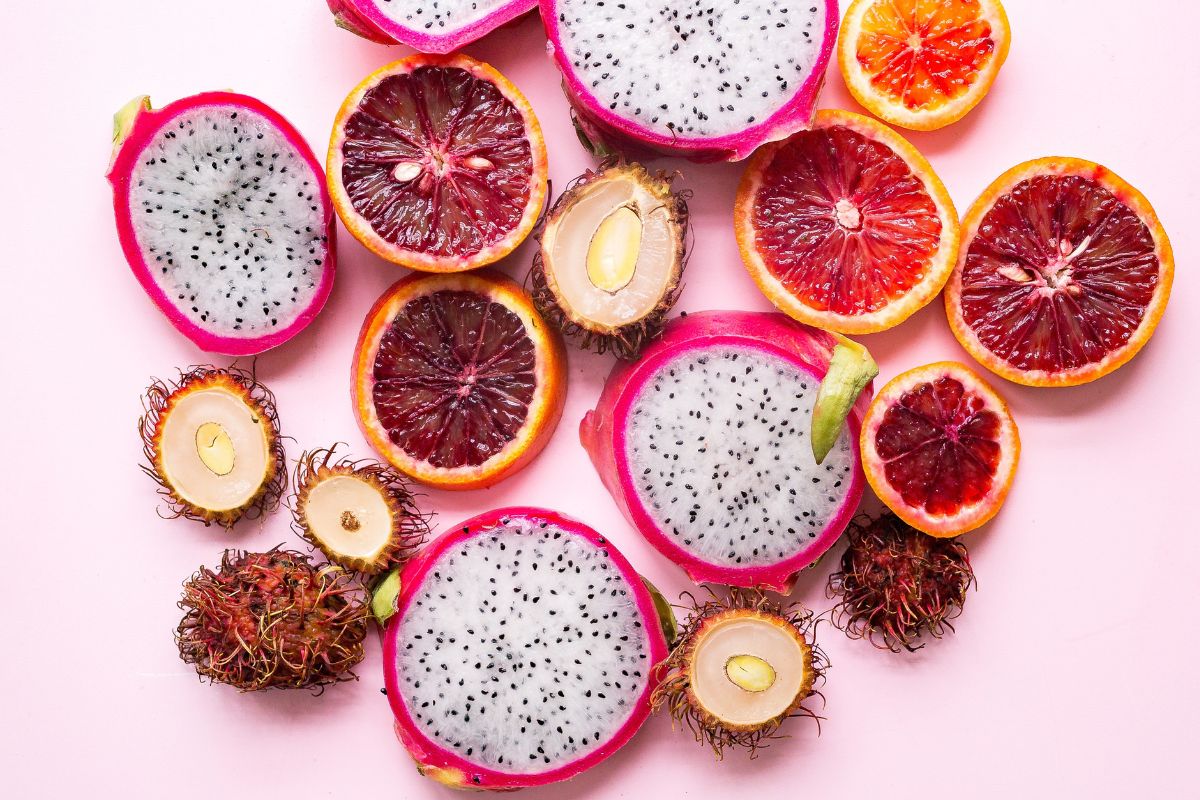Jackfruit, durian, cherimoya, and lychee are excellent exotic fruit options for dehydrating to make healthy snacks with tropical flavor. It's best to dehydrate exotic fruits in a food dehydrator for better temperature control. Dry the fruits for several hours at 130°-140°F, depending on the specific fruit and its water content.
Table of Contents
What Interesting Exotic Fruits Can You Dehydrate?
Most exotic fruits have an interesting appearance, flavor, and smell. From the strong-smelling durian to the star-shaped star fruit, here are some exciting exotic fruits for home dehydration:
1. Jackfruit
The jackfruit is the national fruit of Bangladesh and the world’s largest tree fruit. One jackfruit can weigh up to 80 pounds! Native to Southeast Asia, jackfruits dehydrate well and are often used as a vegan substitute for pulled pork.
Dehydrate jackfruit bulbs in a dehydrator at 135°F for 8-10 hours until chewy and store them for up to one year.
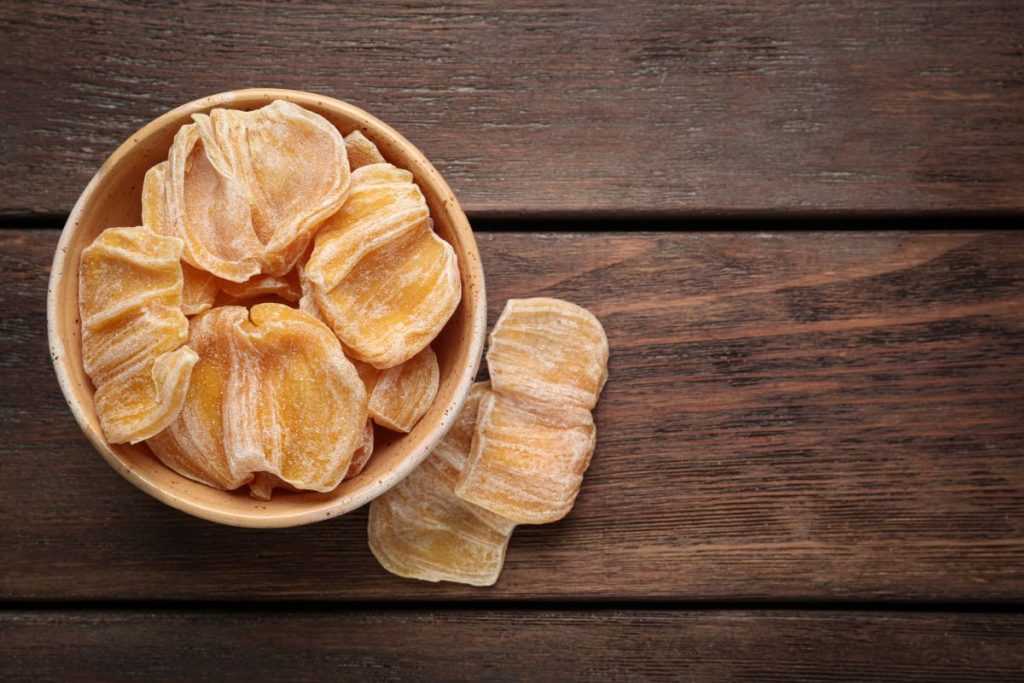
2. Durian
Christened the “king of fruits” in some Asian countries, the putrid-smelling durian is native to Southeast Asia and is commonly eaten in Malaysia, Singapore, and Thailand.
Although the smell of the durian may be off-putting, the fruits are highly nutritious. The dried version of Durian offers significant nutritional value in a small serving size! To dehydrate Durian, dehydrate at 110°F for 8 hours, and flip the pieces halfway through for even drying.
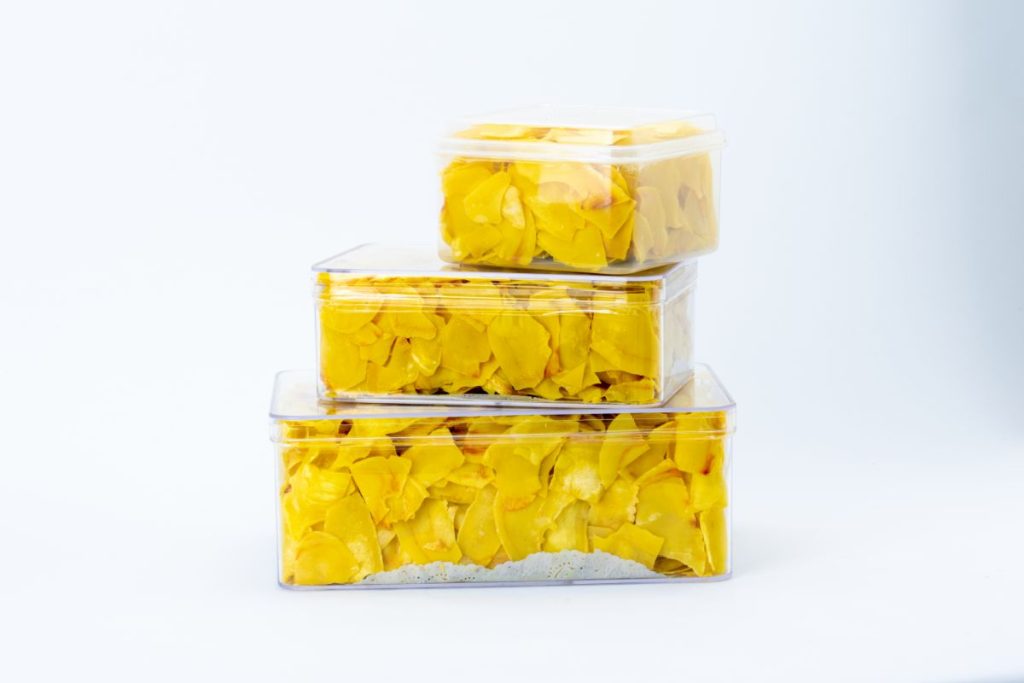
3. Guava
To make dehydrated guava, dry fruit slices at 130°-140°F in a food dehydrator for 14 hours or until dry. This Southeast Asian fruit is delicious and offers many health benefits like proper digestion and dental health.

4. Lychee
Lychees have a short shelf life. To extend the shelf life of this Asian fruit, cut it open to remove the pit and dry it in a dehydrator for 4-12 hours at 135°-140°F.
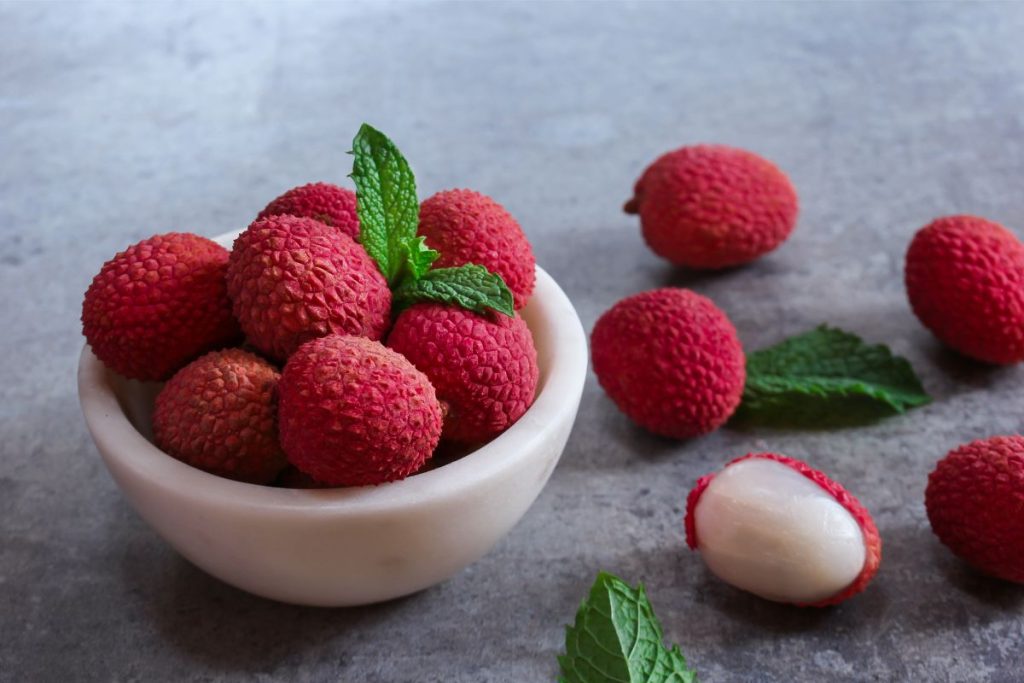
5. Star Fruit
Also called carambola, the star fruit is aptly named for resembling a star when halved. It’s a Southeast Asian fruit with inedible seeds and an intoxicating flavor. It should be dried at 135°F for up to 24 hours.

6. Cherimoya
The oval-shaped cherimoya fruit is native to South America and has soft, white, creamy flesh with a taste that some say is spicy. Scoop out the white flesh for dehydration in a food dehydrator but discard the inedible skin and the seeds as they are poisonous. Dehydrate at 135°F for 12-36 hours until dried through or make fruit leather by blending it, spreading it on fruit roll sheets, and dehydrating for 10-15 hours.

7. Dragonfruit
Despite being a tropical fruit, the dragonfruit has a mild flavor. Dragonfruits are healthy and filled with fiber, iron, and magnesium and have a stunning appearance that makes dehydrated dragonfruit a beautiful, edible garnish.
To dehydrate dragonfruits in a food dehydrator, cut them into thin round slices, sprinkle them with freshly squeezed lemon, and dry them at 135°-145°F for 8-12 hours.
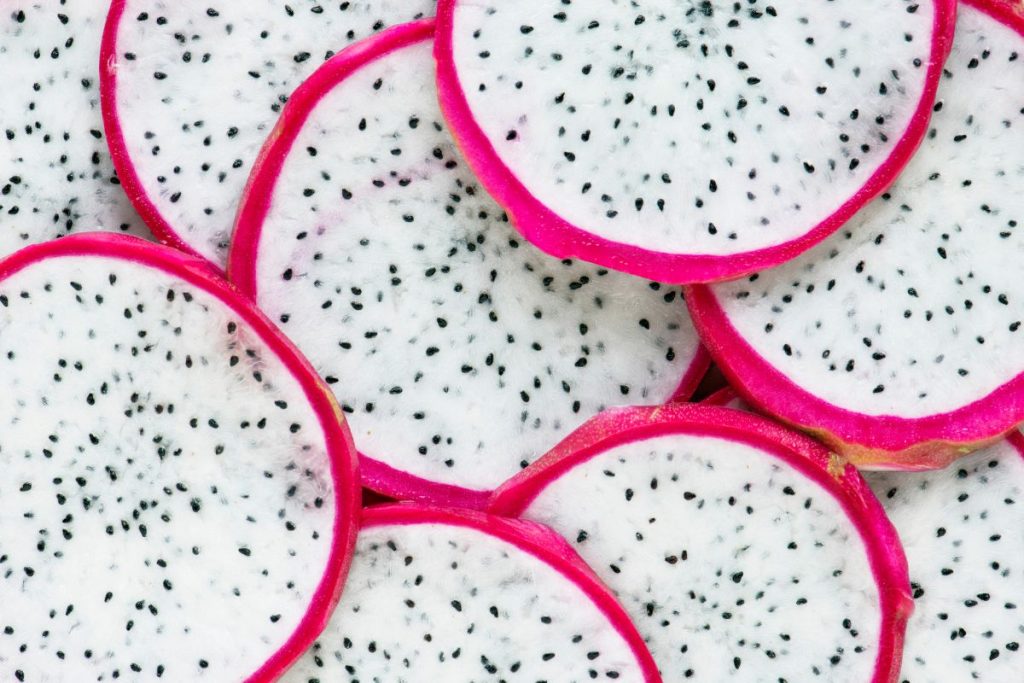
How to Dry Exotic Fruit in a Food Dehydrator
Different exotic fruits have different dehydration procedures depending on the nature of the fruit and what parts are edible. However, many parts of the process are the same, no matter which exotic fruits you are dehydrating. Follow these steps and adjust the preparation as needed for your particular exotic fruit type:
- Choose ripe fruits that are fully mature, firm, and fresh.
- Wash your fruits under cool running water. Use your fingers or a soft vegetable brush to gently scrub the fruits to remove dirt, pesticides, and bugs.
- Use clean kitchen towels or paper towels to dab off excess water droplets on the fruits.
- Prepare the fruits accordingly, depending on the type. Cut through the exterior and remove the skin, cores, seeds, or ribs. You might have to wear hand protection when handling fruits with spiky skin, such as jackfruit.
- Cut or scoop the fruit. Cut into slices, strips, or cubes, depending on the fruit. For example, guava dries best as round slices or lengthwise strips. Ensure thin, uniform pieces with a mandoline slicer for even drying.
- Pre-treat the fruit slices if required. This could be blanching, saltwater soaking or sprinkling pieces with freshly squeezed lemon juice. These pre-treatments prevent darkening or browning during the drying process.
- Enhance bland-tasting fruits with sweeteners like sugar or add spices, if preferred.
- Arrange the fruit pieces in single layers on clean dehydrator trays.
- Place the loaded trays in the food dehydrator and dry the fruits at the “fruit setting” or 135°-145°F for the time recommended. The drying time depends on the type of fruit, its water content, your dehydrator model, and the prevailing humidity.
- Check the fruits occasionally as they dry to avoid darkening. Flip the fruits or rotate the drying trays every few hours for uniform drying.
- After the recommended drying time passes, collect a few fruit pieces from the dehydrator.
- Cool the pieces to room temperature and check them for doneness. Dried exotic and tropical fruits should be leathery, pliable, crispy, or chewy. The doneness depends on the fruit and your preference.
- Keep dehydrating any fruit with evidence of moisture. Once all the fruits have dried, remove them from the dehydrator and cool them to room temperature.
- Keep the dried fruits in airtight dry fruit containers and condition them for 3-7 days. Gently shake each container 1-2 times daily. Check for moisture signs, molding, condensation, or stickiness.
- Repeat the dehydration process for any fruits that have signs of moisture.
- Store the dried fruits in airtight containers in a cool, dark, dry place.

How to Dry Exotic Fruit in an Oven
As with other dried foods, oven-drying poses the risk of burning the food due to a higher temperature. However, with careful monitoring and the following procedure, you can safely dehydrate exotic fruit in an oven:
- Choose high-quality fruits and wash them under cool running water. Use paper towels to pat them dry.
- Prepare the fruits by removing the rinds, seeds, ribs, or cores. Wear hand protection for fruits with spiky or hairy skins.
- Cut the fruits into thin, uniform pieces. Some may need scooping out the flesh, such as cherimoya.
- Pre-treat fruit pieces or flesh by blanching or soaking them with lemon juice or salt water, ascorbic acid, or fruit juice.
- Spread the fruits on clean baking trays. Line the trays with parchment paper if the fruits are too juicy.
- Load the oven and dry the fruits at 170°F or the lowest temperature setting until leathery, chewy, pliable, or crunchy. Leave the oven door a few inches open to aerate the oven and facilitate moisture loss.
- Monitor the dehydration process every hour until the recommended time lapses or the fruits dry.
- Cool several pieces to room temperature and test for dryness by bending or squeezing them. They shouldn’t have any signs of moisture.
- Once all the fruit dries, remove it from the oven and cool it to room temperature before putting it in airtight containers for conditioning and long-term storage.
Should You Dehydrate Dragonfruit in a Dehydrator?
Yes – a food dehydrator is the ideal method for dehydrating dragonfruit or pitaya at home. Drying the fruit in a dehydrator gives you more control over the drying temperature because the fruit is delicate. Dehydrate pitayas at 135°-145°F for 8-12 hours and store them in airtight containers for up to one year.
What is the Quickest Exotic Fruit to Dehydrate?
Bananas and kiwi are some of the quickest exotic fruits to dehydrate in a food dehydrator. Bananas dehydrate in 5-7 hours, while kiwis dry in 6-12 hours at 135°F.
Fruits with more water content take longer to dry, some even up to 24 hours. To dehydrate exotic fruits in a shorter time, use an oven instead of a dehydrator. This will cut the drying time for most fruits in half to roughly 4-6 hours, but there is an increased risk of browning or burning.
What is the Average Time to Dry an Exotic Fruit?
Drying exotic fruits in a food dehydrator can take anywhere from 4-24 hours or more. The drying time changes based on the fruit and its water content, the climate and humidity in the drying area, your dehydrator type, the number of fruits, and the size of the pieces.

What are Some of the Most Popular Fruits to Dehydrate?
Most fruits can be dried, but the best fruit to dehydrate is the one you enjoy eating! There’s no limit to the types of fruits you can dehydrate. Here’s a quick list of popular fruits to dry at home:
- Citrus fruits like grapefruit, lemons, and oranges serve as edible garnishes.
- Dehydrate raspberries or freeze-dry raspberries to spruce up granola.
- Dried apricots are energy dense and full of fiber.
- Freeze-dried blueberries are a delicious, long-lasting treat.
- Go bananas eating America’s most popular fresh fruit.
- Pineapple adds a tropical flavor to granola and trail mixes.
- Sun-dried strawberries or freeze-dried strawberries are a healthy, gluten-free snack.
What Can You Do With Dehydrated Exotic Fruits?
Dehydrated exotic fruits are full of health benefits and packed with nutritional value. Get more antioxidants, carbohydrates, vitamin C, calcium, potassium, and vitamin A by incorporating these fruits into your diet in the following ways:
- Add the fruits to baked goods like dragonfruit cakes
- Enjoy healthy fruit snacks like guava and jackfruit chips
- Incorporate dehydrated fruits in salsas and salads
- Make dried fruit powder for use in smoothie bowls
- Make tropical dried fruit trail mix
- Sweeten hot beverages by adding dried fruit to tea
How to Store Dehydrated Exotic Fruits
To store dehydrated exotic fruits at room temperature, use dry fruit containers such as Mylar bags, glass jars, and Mason jars. Store all containers of dehydrated fruit in a cool, dark, dry place with good ventilation. Ensure all dried food is stored at least 6 inches off of the ground and the stock is rotated regularly.
What is the Shelf Life of Dehydrated Exotic Fruits?
Most dehydrated exotic fruits have a shelf life of 6-12 months in airtight containers kept at room temperature in a cool, dry, dark place. Keeping the fruits in vacuum-sealed containers in the refrigerator or freezer can extend the shelf life to up to 24 months for some dried exotic fruits like bananas.

